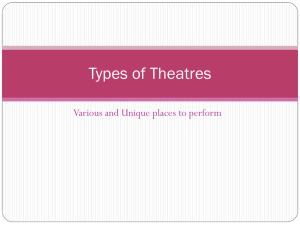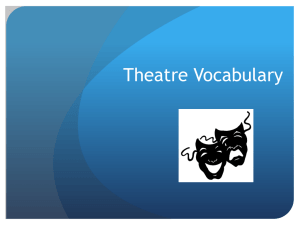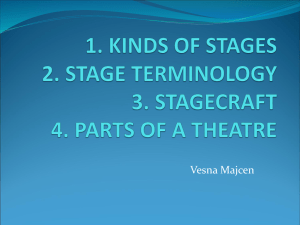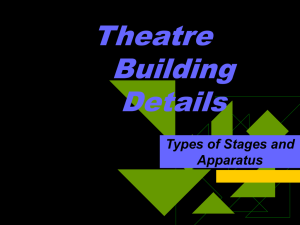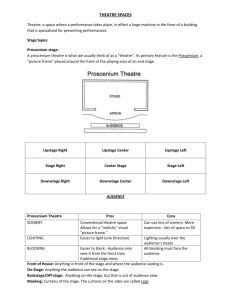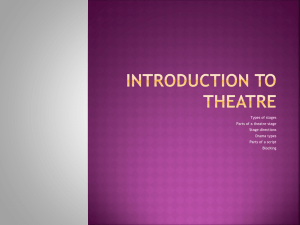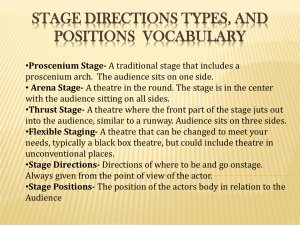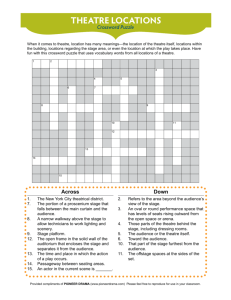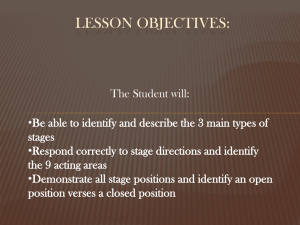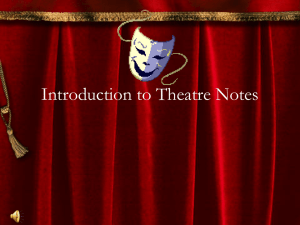Stage types
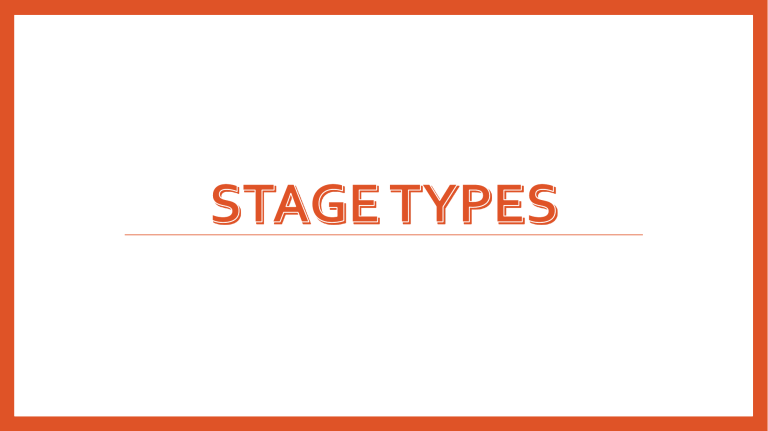
Thrust Theatre
• A stage surrounded by audience on three sides. The fourth side serves as a background.
• In a typical modern arrangement: the stage is often a square or rectangular playing area, usually raised, surrounded by raked seating. Other shapes are possible; Shakespeare's
Globe Theatre was a five-sided thrust stage.
End Stage
• A stage extended wall to wall, like a thrust stage with audience on just one side, i.e. the front.
• "Backstage" is behind the background wall. There is no real wing space to the sides, although there may be entrances located there. An example of a modern end stage is a music hall, where the background walls surround the playing space on three sides. Like a thrust stage, scenery serves primarily as background, rather than surrounding the acting space.
Arena Stage
• A central stage surrounded by audience on all sides. The stage area is often raised to improve sightlines.
“Black Box” Theatre
• These stages are often big empty boxes painted black inside. Stage and seating not fixed. Instead, each can be altered to suit the needs of the play or the whim of the director.
Profile Theatre
• Often used in "found space" theatres, i.e. theatres made converted from other spaces.
• The Audience is often placed on risers to either side of the playing space, with little or no audience on either end of the "stage".
Actors are staged in profile to the audience. It is often the most workable option for long, narrow spaces like "store fronts".
Proscenium
• A proscenium theatre is what we usually think of as a "theatre".
• Its primary feature is the
Proscenium, a "picture frame" placed around the front of the playing area of an end stage.
• The frame is the Proscenium; the wings are spaces on either side, extending off-stage. Scenery can surround the acting area on all sides except side towards audience, who watch the play through picture frame opening.
"Backstage" is any space around the acting area which is out of sight of the audience.
Proscenium
• This type of stage, gives everyone in the audience a good view because the performers need only focus on one direction rather than continually moving around the stage to give a good view from all sides.
• A proscenium theatre arrangement also simplifies the hiding and obscuring of objects from the audience’s view (sets, performers not currently performing, and theatre technology). Anything that is not meant to be seen is simply placed outside the “window” created by the proscenium arch, either in the wings or in the fly space above the stage.
Crossover
• A passage, usually at the rear of the stage, used by performers and staff to move from one side of the stage to the other without coming into the view of the audience.
Wings
• Wing(s) the sides of the stage offstage left and offstage right used for scenery, performer preparation and circulation, and the operation of theatre equipment.
Stage Right
• The part of the stage to the right of a performer facing the audience.
• The area of the stage to the right of center stage when facing the audience.
Stage Left
• The part of the stage to the left of a performer facing the audience.
• The area of the stage to the left of center stage when facing the audience.
Upstage
• At or toward the back of a theater stage.
• Away from the audience.
Downstage
• At or toward the front of a theater stage.
• Towards the audience.
Center Stage
• The center of a stage.
Apron
• The apron is any part of the stage that extends past the proscenium arch and into the audience or seating area.
House
• The seating area or audience chamber of a performance space; auditorium.
• The audience in or relating to the audience chamber.
House Left
• The left section of the audience.
• House Left looks at
Stage right
House Right
• The right section of the audience.
• House Right looks at
Stage left.
